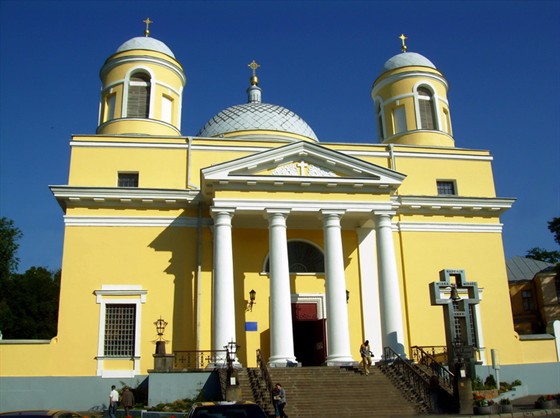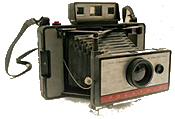Churches & cathedrals |
Kyiv (Kiev) Pechersk Lavra (Monastery of the Caves)
The Kyiv Pechersk Lavra (Ukrainian: Києво-Печерська лавра; Russian: Киево-Печерская лавра), also known as the Kyiv Monastery of the Caves, is an ancient cave monastery in Kyiv. It was founded in 1051 by monks Anthony and Theodosius, and has become an important center of Orthodox Christianity in Kievan Rus′. It′s ongoing development and construction followed for the next 9 centuries. The word "pechera" means cave in the Slavic tongue. The word "lavra" is used to describe high ranking monasteries of the Eastern Orthodox Church. The Lavra buildings looked like small towns with their own streets. In Greek "lavra" means "the street".
Thusly, the name of the monastery is also translated as Kyiv Cave Monastery, Kyiv Caves Monastery or the Kyiv Monastery on the Caves (на печерах). According to the Russian Primary Chronicle, in the early 11th century, Antony, a Greek Orthodox monk from Esphigmenon monastery on Mount Athos, originally from Liubech of the Grand Principality of Chernigov, returned to Rus′ and settled in Kiev as a missionary of monastic tradition to Kievan Rus′. He chose a cave at the Berestov Mount that overlooked the Dnipro River and a community of disciples soon grew. Knyaz (prince) Iziaslav of Kiev ceded the whole mount to the Antonite monks who founded a monastery built by architects from Constantinople.
For more than 900 years the imperishable bodies of the monastery′s founders - the Venerable Anthony and Theodosius, Agapit the healer, Nestor the Chronicler, and relics of another 118 saints lie here.
There are 102 stone structures set in a 26 hectares area, which are recognized architectural monuments.There are also many wonderful paintings, works of arts, old-painted books and crafts.
The Kyiv Pechersk Lavra (Ukrainian: Києво-Печерська лавра; Russian: Киево-Печерская лавра), also known as the Kyiv Monastery of the Caves, is an ancient cave monastery in Kyiv. It was founded in 1051 by monks Anthony and Theodosius, and has become an important center of Orthodox Christianity in Kievan Rus′. It′s ongoing development and construction followed for the next 9 centuries. The word "pechera" means cave in the Slavic tongue. The word "lavra" is used to describe high ranking monasteries of the Eastern Orthodox Church. The Lavra buildings looked like small towns with their own streets. In Greek "lavra" means "the street".
Thusly, the name of the monastery is also translated as Kyiv Cave Monastery, Kyiv Caves Monastery or the Kyiv Monastery on the Caves (на печерах). According to the Russian Primary Chronicle, in the early 11th century, Antony, a Greek Orthodox monk from Esphigmenon monastery on Mount Athos, originally from Liubech of the Grand Principality of Chernigov, returned to Rus′ and settled in Kiev as a missionary of monastic tradition to Kievan Rus′. He chose a cave at the Berestov Mount that overlooked the Dnipro River and a community of disciples soon grew. Knyaz (prince) Iziaslav of Kiev ceded the whole mount to the Antonite monks who founded a monastery built by architects from Constantinople.
For more than 900 years the imperishable bodies of the monastery′s founders - the Venerable Anthony and Theodosius, Agapit the healer, Nestor the Chronicler, and relics of another 118 saints lie here.
There are 102 stone structures set in a 26 hectares area, which are recognized architectural monuments.There are also many wonderful paintings, works of arts, old-painted books and crafts.

St Sophia′s Cathedral
Saint Sophia Cathedral in Kiev (Ukrainian: Собор Святої Софії, Sobor Svyatoyi Sofiyi or Софійський собор, Sofiys′kyi sobor) is an outstanding architectural monument from the Kievan Rus′ era. Today, it is one of the city′s best known landmarks.
The cathedral′s name comes from the Hagia Sophia cathedral in Constantinople, Greece. "Sofia" also means "wisdom" in Greek. The first foundations were laid in 1037 by prince Yaroslav I the Wise. The exterior was covered with plinths. The cathedral has 5 naves, 5 apses, and,quite surprisingly for a Byzantine structure, 13 cupolas (domes). The azure and white bell tower is 76meters high and was finished in 1752. It is surrounded by two-tier galleries from three sides. On the inside, it has mosaics and frescos from the 11th century, which were created with a unique technology, depicting Scriptural scenes, individual figures of Church Fathers, Apostles, maidens and warriors.
This majestic cathedral became a holy place of worship for Kyivany, as well as a politicial and cultural center. It was also known as a seat of the Kiev Metropolitan. The first known library in ancient Rus and the first school for boys and girls were both founded by Yaroslav the Wise.
The cathedral achieved its present Ukrainian baroque aspect after its reconstruction in the late 17th century, being completed in 1707.
In 1934 the structure was confiscated by the Soviets and designated as an architectural and historical museum/reserve, including the surrounding 17th/18th century architectural ensemble. The cathedral was the first Ukrainian patrimony to be included in the World Heritage List.
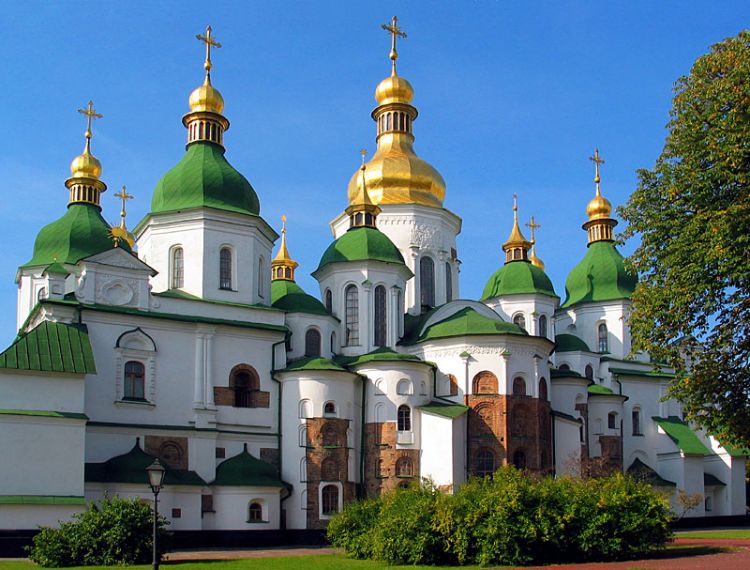
St. Michael′s Golden Domed Cathedral
This multi-tiered church complex is situated just opposite Sophia Cathedral and seems to reign on the steep bank of the Dnipro in all its glory. Originally built by a grandson of Yaroslav the Wise, Kiev Prince Sviatopolk Izyaslavovich in 1108, this cathedral was one of the biggest monasteries of ancient Kyiv. St. Michael′s Cathedral, hallowed in the name of Kyiv′s saint patron - Archangel Michael. Since the beginning of the thirteenth century the Monastery had kept its prized sacred object - St. Martyr Barbara′s relics. Now the relics reside at St. Vladimir′s Cathedral.
"The substantial stone construction started in 1710, when the stone refectory, three-tiered belfry and the Cathedrals two large side-chapels were erected. The latter′s construction was filled unsuccessfully, and, as a result the Cathedral started to decline in ruin. In 1740 a reinforcment of the abutments to strengthen the walls was done. In 1888 the cathedral was equipped with radiator heating, which also required certain rennovations.
The most noteable construction at the end of the nineteenth - the beginning of the twentieth centuries was the so-called "Inn-court". The Hotel complex of St. Michael′s Monastery was built in 5 phases during the period between 1857 and 1907. It became second only to the hotel at the Lavra, as the largest hotel in Kyiv. In addition, in 1898 another noteable building was added; St. Barbara′s section. Thus, was created the "background structure" of the Monastery.
The Cathedral′s original interior was adorned with Old-Rus′ mosaics and frescos. Some of them were discovered during the reconstruction of 1888. The Cathedral′s famous altar mosaic composition "Evcharistia" was preserved, and is on exhibit now in St. Sofia Cathedral. Some of the single fresco and mosaic images are now kept in museums of Moscow and St. Petersburg."
St. Michael′s Golden Domed Cathedral and some of the Monastery buildings were destroyed in 1934 through 1936 by the Soviet regime of the mid-30s in keeping with their anti-religious propaganda for building a Soviet government center instead. (Currently the Ministry of Foreign affairs building).
Its reconstruction of the original site was completed in 2000 and is a sign of spiritual rebirth of Kiev. The sky blue exterior and glittering golden domes seem a bit too new and shiny for this ancient city, but they are certainly stunning.
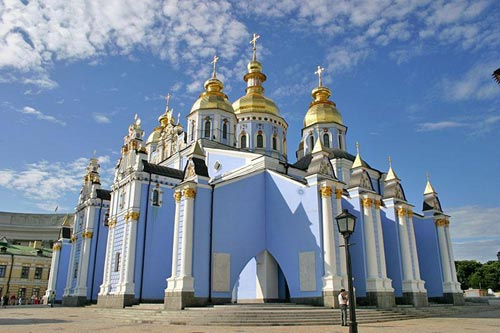
St. Andrew′s Church
The baroque St. Andrew′s Church or the Cathedral of St. Andrew was built in Kyiv between 1747 and 1754, and designed by the imperial architect Bartolomeo Rastrelli.
Overlooking the ancient Podil district from a steep hill, this exuberant and colourful structure with one large dome and five lesser cupolas is one of the city′s best known landmarks.
The church was built by a team of Ukrainian masters under Ivan Michurin, the principal architect of Moscow.
It was to replace the older "Church of the Resurrection", on the Women′s Market Square (Babiy Torzhok). Legend has it that it was the spot where St. Andrew erected a cross and prophesied the foundation of a great Christian city in what was then a sparsely inhabited area.
Since 1968, the church has been open to visitors as a museum. Occasionally the edifice is used for services of the Ukrainian Autocephalous Orthodox Church, one of several national churches unrecognized by major Orthodox patriarchates.
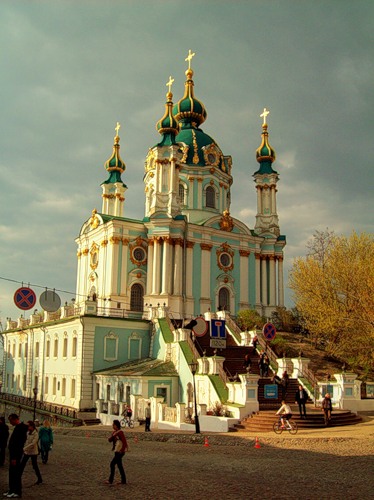
St. Volodymyr Cathedral
St. Volodymyr′s Cathedral is another one of Kiev′s major landmarks and the "Mother Cathedral" of the Ukrainian Orthodox Church Kiev Patriarchy. One of two major Orthodox Churches in Ukraine, it is, however, viewed, uncanocical by the Eastern Orthodox Communion. It is one of the three greatest Orthodox churches built in the 19th century, on par with St Isaac′s in St Petersburg and Christ the Saviour in Moscow.
In 1852, metropolitan Philaret of Moscow suggested a large cathedral should be built in Kiev to commemorate the 900th anniversary of the baptism of Kievan Rus. People from all over the Russian Empire started donating to this cause, so that by 1859 the cathedral fund had amassed a huge sum of 100,000 rubles. The Kiev Pechersk Lavra (Monastery of the Caves) produced 1 million bricks and donated them to the cathedral as well. The design was executed in a delightful Byzantine style by architects Ivan Schtrom and Alexander Beretti. Being stymied by numerous technical problems, the construction work lagged on for three decades. On August 20, 1896, the cathedral was finally consecrated to St Volodymyr in the presence of Nicholas II and Alexandra Feodorovna.
It is the cathedral′s colourful interior that particularly strikes the eye. Mosaics were created by masters from Venice. Frescoes were the work of three outstanding Russian painters of the day: Viktor Vasnetsov, Mikhail Vrubel, and Mikhail Nesterov. Iconostasis is carved from the white marble brought from Carrara.
The construction and interior deco took more than 30 years (1862-96) to complete. This seven dome three-aisled church resembles the buildings of old Ukraine only slightly. Its walls are drenched with ornamental detail. The interior is a reflectiion of the Prince Vladimir period. The main facade is decorated with a double door made of oxidized bronze with enamel, carving and openwork tracery. On the sides of the door are figures of Princess Olga and Prince Vladimir made of embossed bronze and portrayed against a blue enamel background.
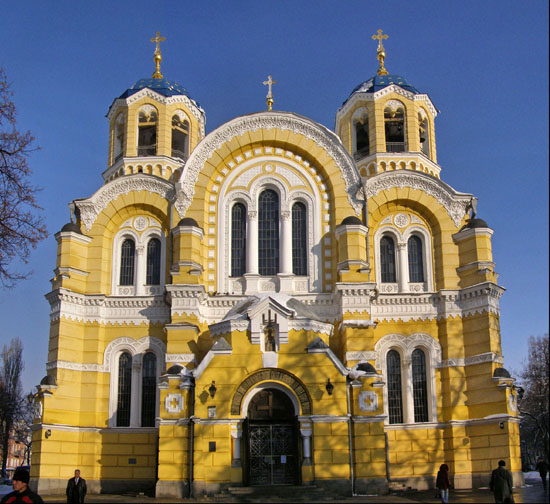
St. Nikolas Roman-Catholic church
St. Nicholas Cathedral is one of the most beautiful buildings of Kiev from the 19th and early 20th century deigned in formalized gothic style with high arrow-shaped spires.
The solemn laying of the foundation stone of St. Nicholas Roman Catholic Cathedral took place in august of 1899, after local Catholics turned to Kiev′s Governor-General with a petition to get permission for the construction of a cathedral “in commemoration Tsar Nikolay II having stayed in Kiev”. By that time in Kiev there already was one Roman Catholic cathedral – Alexander’s Cathedral - but taking into account that there were around 40 thousand Catholics in Kiev, it was obviously not enough.
The cathedral was built over a period of 10 years by private donations. In total, around 500 thousands rubles were spent.
A competition was held for the Cathedral project and the winner was a student named Stanislav Volovskiy. Inasmuch as this young engineer lacked practical experience, the revision and building supervision was entrusted to a famous Kiev architect - Vladislav Gorodetskiy. The construction work dragged on because of poor ground condition, that’s why, for the first time in Kiev, the soil was strengthen by mighty cast-in-
During the Soviet era when religion was considered detrimental and unfavorable, the Cathedral was closed for public worship, and at the beginning of World War II a State regional archive was put there.
Only in 1980 in the year of the Olympic Games was the cathedral was restored and opened as an organ and chamber music hall. The organ was constructed specially for this hall. When creating the organ, the masters tried as much as possible to arrange its appearance to match the architectural style of the cathedral, and thus were joined a unique architecture and a unique instrument. The Organ has 55 spots, 3,945 organ-pipes of various diameter (from 13 mm to 6 meters) made from metal and precious woods (black and red).
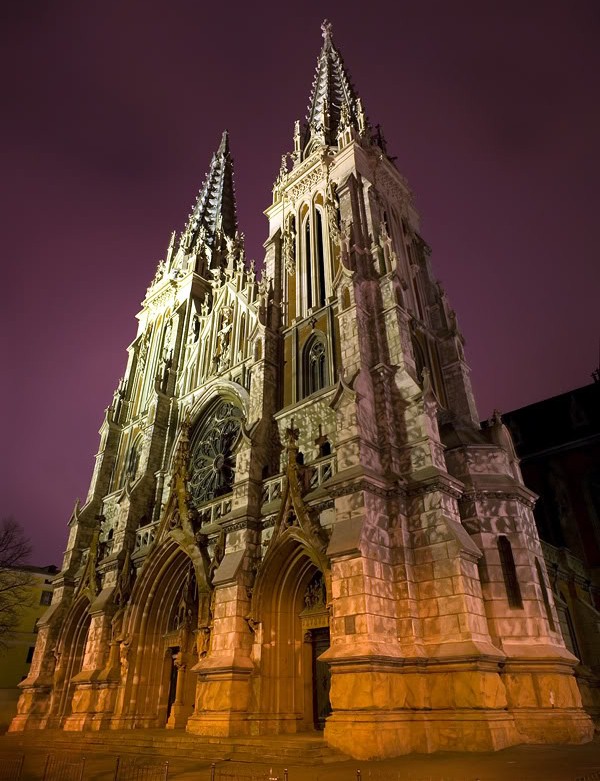
St. Alexander Catholic Church
Alexander Church, located near the Independence Square and Khreshchatyk, is not only the oldest Roman Catholic Church in Kiev, but also the main Catholic Temple of this city. It was named after Tsar Alexander I, who ordered to build the church.
The decision to erect church arose in the early XIX century, because the 46000 of the Roman Catholics in Kiev did not have the own temple for worship. In 1817 there started the construction of the church, financed by the Polish gentry, and ended only in 1842.
The Catholic Church was built in the tradition of the era of that time and has a stamp of classicism. It is characterized with clean lines, square form, topped with domes and towers. A distinctive feature of the church is its rich decoration and the main entrance, decorated with the portico. The main relic is the crucifix brought from Italy and the excellent copy of Raphael Madonna.
In Soviet times the Alexander Church was closed. In the building there was opened the planetarium and the library; the church was almost completely neglected. The restoration was carried out in 1994, three years later as it was returned to the Roman Catholic community.
Nowadays, the uniqueness of the church lies in its architecture and sumptuous luxury.
The decision to erect church arose in the early XIX century, because the 46000 of the Roman Catholics in Kiev did not have the own temple for worship. In 1817 there started the construction of the church, financed by the Polish gentry, and ended only in 1842.
The Catholic Church was built in the tradition of the era of that time and has a stamp of classicism. It is characterized with clean lines, square form, topped with domes and towers. A distinctive feature of the church is its rich decoration and the main entrance, decorated with the portico. The main relic is the crucifix brought from Italy and the excellent copy of Raphael Madonna.
In Soviet times the Alexander Church was closed. In the building there was opened the planetarium and the library; the church was almost completely neglected. The restoration was carried out in 1994, three years later as it was returned to the Roman Catholic community.
Nowadays, the uniqueness of the church lies in its architecture and sumptuous luxury.
